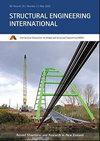用直接强度法设计机架柱的可靠性
IF 1.4
4区 工程技术
Q3 CONSTRUCTION & BUILDING TECHNOLOGY
引用次数: 0
摘要
摘要冷弯机架型材主要用于工业存储系统。它们复杂的几何形状和沿其长度存在的孔图案使得这些结构元件的强度预测变得困难。本文通过直接强度法(DSM)的适应性来评估机架柱设计中的安全性,其原始公式没有解决穿孔问题。这里使用的安全参数是通过一阶二阶矩法(FOSM)计算的可靠性指标,用于AISI S100现行标准的校准,一阶可靠性法(FORM)和蒙特卡罗模拟。只有在截面建模中应用减厚法的方法才能产生接近冷成形柱的目标可靠性指标的结果。仅考虑畸变屈曲破坏时,所有荷载组合均满足目标指标。然而,当考虑到局部屈曲破坏时,DSM调整仍然不精确。由于使用电流φ =0.85的设计不符合安全要求,因此针对这些情况校准了新的专业因素。关键词:工业存储系统机架柱直接强度法结构可靠度可靠度指标阻力因子致谢本研究部分由巴西国家协调机构(CAPES)财政代码001资助。作者感谢欧鲁普雷图联邦大学(UFOP)和Teoman教授Peköz和Miquel Casafont教授提出的建议。披露声明作者未报告潜在利益冲突。数据可用性声明支持本研究结果的数据可根据合理要求从通讯作者V.A.M. de Faria处获得。本文章由计算机程序翻译,如有差异,请以英文原文为准。
Reliability of Rack Columns Designed by the Direct Strength Method
AbstractCold-formed rack profiles are produced mainly for use in industrial storage systems. Their complex geometry and the presence of hole patterns along their length make the strength prevision of these structural elements difficult. This article evaluates the safety presented in the design of rack columns by adaptations of the Direct Strength Method (DSM), the original formulation of which does not address perforations. The safety parameters used here are the reliability indexes, calculated by the First Order Second Moment (FOSM) method, used in the calibration of the AISI S100 current standard, the First Order Reliability Method (FORM) and Monte Carlo Simulation. Only methodologies that applied the reduced thickness method in cross-section modelling produce results close to the target reliability indexes suggested for cold-formed columns. The target indexes are met for all load combinations when only distortional buckling failure is considered. However, the DSM adaptations are still imprecise when considering failure with local buckling. New professional factors were calibrated for these cases, as the design using the current ϕ=0.85 does not meet the safety requirements.Keywords: industrial storage systemsrack columnsdirect strength methodstructural reliabilityreliability indexesresistance factors AcknowledgementsThis study was financed in part by the Coordenação de Aperfeiçoamento de Pessoal de Nível Superior - Brasil (CAPES) - Finance Code 001. The authors are grateful to the Federal University of Ouro Preto (UFOP) and Professors Teoman Peköz and Miquel Casafont for their suggestions.Disclosure StatementNo potential conflict of interest was reported by the authors.Data Availability StatementThe data that support the findings of this study are available from the corresponding author, V.A.M. de Faria, upon reasonable request.
求助全文
通过发布文献求助,成功后即可免费获取论文全文。
去求助
来源期刊

Structural Engineering International
CONSTRUCTION & BUILDING TECHNOLOGY-ENGINEERING, CIVIL
CiteScore
2.60
自引率
9.10%
发文量
78
审稿时长
6-12 weeks
期刊介绍:
The aim of the Association is to exchange knowledge and to advance the practice of structural engineering worldwide in the service of the profession and society.
 求助内容:
求助内容: 应助结果提醒方式:
应助结果提醒方式:


